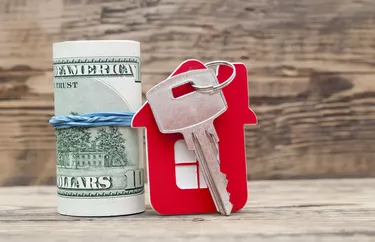
You can give your house back to the bank through a voluntary process called "deed in lieu of foreclosure." Homeowners who realize they can no longer afford their home often choose this route instead of allowing the bank to foreclose on the property. The bank benefits by saving on the legal fees necessary for a forced foreclosure. With a deed in lieu of foreclosure, you voluntarily transfer all rights to the property to the bank. The bank then cancels the remaining balance on your mortgage, and you walk away with no further responsibility for the home.
Step 1
Place your house on the market. The bank knows that if it takes your property, it'll have to sell it. Before that happens, the bank would like to see you give it a try. Putting the house up for sale will be an important signal to the bank that you're doing everything you can to escape the mortgage.
Video of the Day
Step 2
Check your mortgage statement. The bank is unlikely to take you seriously or consider your request for a deed in lieu of foreclosure unless you are behind on your mortgage payments. After all, if your payments are all up to date the bank may decide that you're doing just fine handling your mortgage payments. Generally, you become a candidate for foreclosure when you fall more than 30 days behind, and pressure from the bank becomes more intense as you fall further behind. The Federal Trade Commission says that's when banks will consider deed in lieu of foreclosure requests.
Step 3
Call your bank. Speak to a mortgage loan officer and tell her you that you have fallen behind on your payments and can no longer afford to pay for your home. Tell her you would like to surrender the title to the bank through a deed in lieu of foreclosure. The bank may suggest alternatives, including loan modification programs that could lower your monthly payments.
Step 4
Write a letter to your mortgage company reiterating the discussion you had on the telephone with the loan officer. Make a strong case for a deed in lieu of foreclosure by explaining why this option is best for you and the bank. List all the hardships that are preventing you from paying your mortgage. Possibilities include long-term unemployment, catastrophic medical bills or disability. Finish your letter by requesting an appointment to speak face to face.
Step 5
Meet with your mortgage loan officer and again state your case. Wait for the bank's decision. If the decision is "yes," you'll be given paperwork to sign and a timetable for moving out.
Tip
A deed in lieu of foreclosure has fewer tax consequences and is less damaging to your credit than a forced foreclosure.
Warning
According to the Federal Trade Commission, a deed in lieu of foreclosure may not be possible if you have tax liens against the property, or you have loans on the home including home equity loans or second or third mortgages. Liens and loans would kill the deal, because the bank would require your home to have a clear title before moving forward. Also, the bank is not obligated to agree this and could file for regular foreclosure if you default on your loan.
Video of the Day